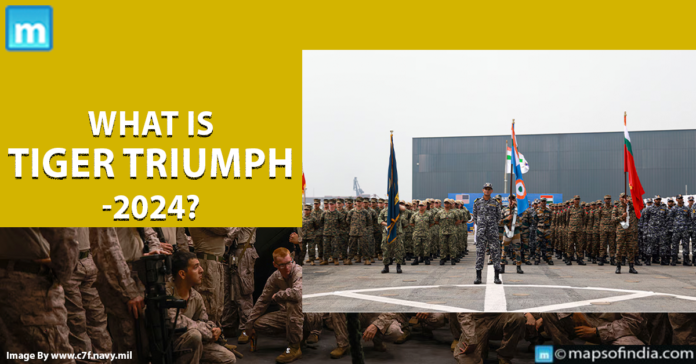The common ideals that underpin the strategic alliance between the United States and India include a dedication to democracy and the maintenance of the rules-based international order. With the four other members of the Quad Forum (Malabar), the US and Indian armed forces participate in significant bilateral and multilateral military drills. Tiger Triumph 2024, a bilateral tri-service amphibious exercise between the US and India for humanitarian assistance and disaster relief (HADR), was conducted on March 30. The exercise’s goal is to share best practices and SOPs for cooperative HADR operations.
Phases of the exercise
From March 18 to 25, Visakhapatnam hosted the Harbour Phase of the exercise, which featured ship boarding drills, sports engagements, subject matter expert exchanges, and pre-sail discussions.
To set up a joint command and control centre and a joint relief and medical camp for HADR operations, the Indian Navy and the US Navy conducted maritime exercises at sea. They landed troops at Kakinda during the exercise’s sea phase, which lasted from March 26 to 30.
Inclusions in the exercise
During the practice, three helicopters were used for cross-deck operations. A landing platform dock, large landing ship tanks, helicopters, a guided missile frigate, and long-range maritime reconnaissance aircraft were all deployed by the Indian Navy.
In contrast, the Indian Army equipped one Infantry Battalion Group with mechanized forces, while the Indian Air Force stationed one medium-lift aircraft, one transport helicopter, and one Rapid Action Medical Team (RAMT).
Importance of Tiger Triumph
Sharing best practices and standard operating procedures in conducting multinational HADR operations was the exercise’s goal, representing the “robust strategic partnership” between the two nations.
Indian Navy aircraft, Indian Army men and vehicles, Indian Air Force aircraft and helicopters, Indian Navy landing craft, and the Rapid Action Medical Team (RAMT) participate in this exercise. According to the statement, the Indian Air Force had sent out a transport helicopter, a medium-lift aircraft, and a Rapid Action Medical Team (RAMT). The Indian Army was represented by one Infantry Battalion Group, which included mechanized soldiers.
The US Task Force consisted of a destroyer, medium-lift aircraft, maritime reconnaissance planes, US Marines, and a US Navy landing platform dock with integrated landing craft air cushions and helicopters, according to the statement.
Other Exercises Between India and the US
Yudh Abhyas: This is India and the US’s longest-running bilateral military training and defence cooperation project. It began in 2004 as part of the US Army Pacific Partnership Program. Each of the two nations hosts the exercise in turn.
Vajra Prahar: India and the United States alternately host the combined drill involving their respective Special Forces. The Special Forces Training School in Bakloh, Himachal Pradesh, hosted the eleventh iteration of the exercise. Improving communication between the two countries’ special forces is another goal, along with exchanging best practices and experiences in areas like cooperative mission planning and operational techniques.
Cope India: 2004 Cope India was first conducted as a fighter training exercise. In 2019, the practice underwent its most current iteration. Large-force exercises, air mobility training, airdrop training, subject matter expert exchanges, and fighter training exercises have all been added to the exercise.




